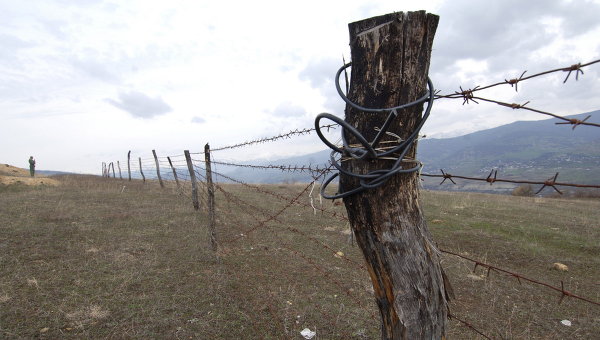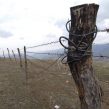
Russia Gradually Expands Its Occupation Zone in Georgia
Publication: Eurasia Daily Monitor Volume: 10 Issue: 168
By:

On September 17, Russian occupation forces in Tskhinvali region (South Ossetia) renewed erecting fences and barbed wire in the Georgian village of Ditsi, which is located on the southern edge of the Russian-occupied Georgian region. Russians once again moved the occupation line hundreds of feet deeper into Georgian-controlled territories, cutting off the village residents’ access to a local cemetery and an irrigation reservoir (Rustavi 2, Civil Georgia, September 17).
This unilateral redrawing of the de facto line of control is just the latest example of Russia trying to seize more Georgian territories beyond those it already occupies. Since 2009, Russia has gradually been expanding the occupation zone in almost all directions—bit by bit, slicing off several miles or even just hundreds of feet of territory deeper into the rest of Georgia on every attempt. As a result, various Georgian villages, sitting on the edge or close to the occupation zone, have lost their orchards, many acres of arable lands, access to schools, drinking and irrigation water reservoirs, cemeteries, and main roads (Civil Georgia, June 21, 2009; May 27–29, 2013; June 4, 2013). By these measures, Russia deliberately affects the livelihoods of local Georgian communities, forcing them to leave the region.
After the September 17 incident, the Georgian government once again appealed to the international community to help halt Russia’s creeping occupation of additional Georgian territories. James Apathurai, the North Atlantic Treaty Organization’s (NATO) special representative for the Caucasus and Central Asia, expressed concern on his Facebook page about the ongoing developments (times.ge, September 18). Moreover, the United States’ Embassy in Georgia stated that it was “deeply concerned” over the creation of border lines in the region and called for the removal of these barriers (Rustavi 2, September 20). Earlier, in May, the US Department of State also expressed concern over the installation of fences by the Russian troops (Civil Georgia, May 31).
However, Russia does not seem deterred by such statements. On September 22, Russian occupation forces renewed their activities of erecting barbed wire, this time in the village of Dvani, which sits on the southern edge of the occupation zone. Russians moved the occupation line about 1,500 feet deeper into Georgian controlled territory, absorbing additional acres of arable lands, orchards, and portions of the irrigation system—thus adding to the local Georgian population’s desperation (tv.ge, ghn.ge, September 22). This was the second time in two months that the Russian side has moved the occupation line deeper into Dvani (for.ge, September 22). So far, the European Union’s Monitoring Mission (EUMM) in Georgia, which is deployed to observe the Russian-Georgian ceasefire agreement, has not been particularly effective at arresting this gradually advancing Russian occupation.
It is also noteworthy that the latest Russian encroachment on Georgian territories coincided with a highly provocative interview given by the influential Russian ideologue and unofficial Kremlin mouthpiece Alexander Dugin. In particular, Dugin declared that Georgia’s Samegrelo region (in the western part of the country) will soon follow Abkhazia and South Ossetians in its bid to break away from Georgia. Dugin, in fact, warned Georgia that its disintegration process will not stop there: Adjara and Javakheti will try to separate from the country as well. As he declared, Russia should become involved and support all these separatist movements. Furthermore, he called Georgia a “failed state,” accusing the country of actually being nothing more than a multi-ethnic, artificial construction that tries to impose the idea of single nationhood on others. He suggested that Russia had a role to help and save the nations “oppressed” by Georgians (frontnews.ge, September 22).
Whether through sending warnings by the words of Alexander Dugin or gradually slicing off bits of additional Georgian territories, Moscow is making it clear to Tbilisi that the continuing territorial dismemberment of Georgia will continue. Clearly, the current Georgian government’s policy of rapprochement with Russia is failing to yield tangible results with regard to the occupied Georgian regions. For the time being, Moscow uses its creeping expansion beyond the Tskhinvali region as a pressure point through which it can influence Tbilisi. Moreover, by constantly expanding the occupation zone, Russia tries to keep the flashpoint for conflict alive and, in fact, invites Georgia into an open clash. Evidently, Moscow believes that if it feels it necessary to, it can reactivate this conflict at any time, dragging Georgia into a renewed, wide-scale, devastating conflict, finally shattering even remote dreams of a united, stable and prosperous Georgia. On its own, Georgia is unlikely to be able to stop the creeping Russian advance into Georgian-controlled territories. It needs concrete help from its friends in the West. The failure to arrest this slow-motion process now, may damage short- and medium-term prospects for peace in Georgia and the wider Caucasus region, as well as badly impact the West’s standing not only in Georgia, but elsewhere in the post-Soviet space—where Russia’s position still appears quite strong.




